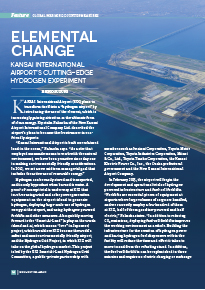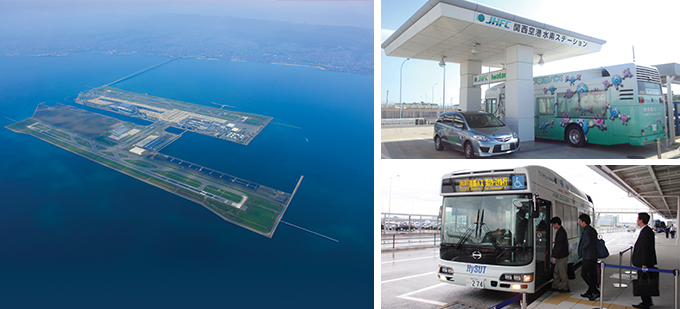Home > Highlighting JAPAN >Highlighting Japan February 2015>Global warming countermeasures
Highlighting JAPAN

Global warming countermeasures
Elemental Change
Kansai International Airport’s
cutting-edge hydrogen experiment

Kansai International Airport (KIX) plans to transform itself into a “hydrogen airport” by introducing the use of the element, which is increasingly gaining attention as the ultimate form of clean energy. Kiyotaka Nakaoka of the New Kansai Airport International Company Ltd. described the airport’s plans to become the frontrunner in eco-friendly airports.
“Kansai International Airport is built on reclaimed land in the ocean,” Nakaoka says. “As a site that employed manmade means to work with the natural environment, we have been proactive since day one in making environmentally friendly considerations. In 2012, we set a new midterm managerial goal that includes the active use of renewable energy.”
Hydrogen can be easily stored and transported, and its only byproduct when burned is water. A proof-of-concept trial is under way at KIX that involves using wind and solar power generation equipment on the airport island to generate hydrogen, deploying large-scale use of hydrogen energy at the airport, and using hydrogen-powered forklifts and other measures. Also quickly moving forward is the “Smart Ai-Land” (a play on the words island and ai, which means “love” in Japanese) project, which would see KIX become the world’s safest and most environmentally friendly airport, and the Hydrogen Grid Project, in which KIX will take on the global hydrogen market. This project is led by the KIX Smart Ai-Land Hydrogen Grid Committee, a public-private partnership with members such as Iwatani Corporation, Toyota Motor Corporation, Toyota Industries Corporation, Mitsui & Co., Ltd., Toyota Tsusho Corporation, the Kansai Electric Power Co., Inc., the Osaka prefectural government and the New Kansai International Airport Company.
In February 2015, the airport will begin the development and operational trials of hydrogen-powered infrastructure and fuel-cell forklifts. “Forklifts are essential pieces of equipment at airports where large volumes of cargo are handled, and we currently employ a few hundred of them at KIX, half of them gasoline-powered and half electric,” Nakaoka states. “In addition to reducing CO2 emissions, deploying fuel-cell forklifts improves the working environment as a whole. Building the infrastructure for the creation of hydrogen power and having hydrogen fuel dispensers within the facility will reduce the time and effort it takes to move to and from the refueling stand. In addition, the fuel-cell forklifts can be replenished in three minutes and require no electric charging or exchange of batteries to remain in continuous operation. This integrated chain of improvements enhances overall working efficiency.”
It will still be some years before KIX can completely switch over to fuel-cell forklifts, but when that day arrives, a considerable rate of CO2 reduction versus gas and electric is anticipated. After fuel-cell forklifts, the next plan is to switch to hydrogen in the towing tractors used to haul freight containers to aircraft. That will cut KIX’s CO2 emissions across the board.
According to Nakaoka, “We are planning to set up a commercial hydrogen station on the island, which will be used for hydrogen replenishment for the fuel-cell vehicles and fuel-cell buses that we are planning to adopt. There is also a plan to use the hydrogen fuel cell-powered buses charged at the commercial hydrogen station as limousine buses to connect Osaka International and Kansai International airports. In the future, we also want to power our hydrogen generators using renewable energies like solar and wind power, store the hydrogen in tanks and fuel cells, and then provide that energy to the airport terminal buildings. Even if the electrical grid goes down as the result of a disaster, this system will allow us to stay up and running. That makes it a key project from the standpoint of disaster preparedness as well.”
KIX plans to host tours of the airport that incorporate environmental experiential routes, as well as using a hydrogen-themed display booth at the hydrogen station, transforming the site into an early model of the “hydrogen airport,” a concept that is also gaining traction overseas. Through these projects, KIX wants to actively promote awareness of the safety and sensibility of hydrogen power.
“The Hydrogen Grid Project revolves around KIX, but the whole process runs thanks to the technology various companies have provided and the invaluable support of the Ministry of the Environment, Ministry of Economy, Trade and Industry and the Cabinet Office,” Nakaoka says firmly. “Without the right technology, capital and legislation in place, it is difficult to quickly meet our various goals and promote Japan’s excellent hydrogen technologies. We need to continue these public and private collaborations to move this project forward full steam—or should I say, hydrogen—ahead.”
© 2009 Cabinet Office, Government of Japan






